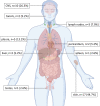Molecular profiling and clinical implications of patients with acute myeloid leukemia and extramedullary manifestations
- PMID: 35562747
- PMCID: PMC9107142
- DOI: 10.1186/s13045-022-01267-7
Molecular profiling and clinical implications of patients with acute myeloid leukemia and extramedullary manifestations
Abstract
Background: Extramedullary manifestations (EM) are rare in acute myeloid leukemia (AML) and their impact on clinical outcomes is controversially discussed.
Methods: We retrospectively analyzed a large multi-center cohort of 1583 newly diagnosed AML patients, of whom 225 (14.21%) had EM.
Results: AML patients with EM presented with significantly higher counts of white blood cells (p < 0.0001), peripheral blood blasts (p < 0.0001), bone marrow blasts (p = 0.019), and LDH (p < 0.0001). Regarding molecular genetics, EM AML was associated with mutations of NPM1 (OR: 1.66, p < 0.001), FLT3-ITD (OR: 1.72, p < 0.001) and PTPN11 (OR: 2.46, p < 0.001). With regard to clinical outcomes, EM AML patients were less likely to achieve complete remissions (OR: 0.62, p = 0.004), and had a higher early death rate (OR: 2.23, p = 0.003). Multivariable analysis revealed EM as an independent risk factor for reduced overall survival (hazard ratio [HR]: 1.43, p < 0.001), however, for patients who received allogeneic hematopoietic cell transplantation (HCT) survival did not differ. For patients bearing EM AML, multivariable analysis unveiled mutated TP53 and IKZF1 as independent risk factors for reduced event-free (HR: 4.45, p < 0.001, and HR: 2.05, p = 0.044, respectively) and overall survival (HR: 2.48, p = 0.026, and HR: 2.63, p = 0.008, respectively).
Conclusion: Our analysis represents one of the largest cohorts of EM AML and establishes key molecular markers linked to EM, providing new evidence that EM is associated with adverse risk in AML and may warrant allogeneic HCT in eligible patients with EM.
Keywords: Acute myeloid leukemia; Chloroma; Extramedullary; Leukemia cutis; Myeloid sarcoma.
© 2022. The Author(s).
Conflict of interest statement
The authors declare that they have no competing interests.
Figures




References
-
- King A. Case of chloroma. Mon J Med Sci. 1853;8(44):97.
Publication types
MeSH terms
Substances
LinkOut - more resources
Full Text Sources
Medical
Research Materials
Miscellaneous

